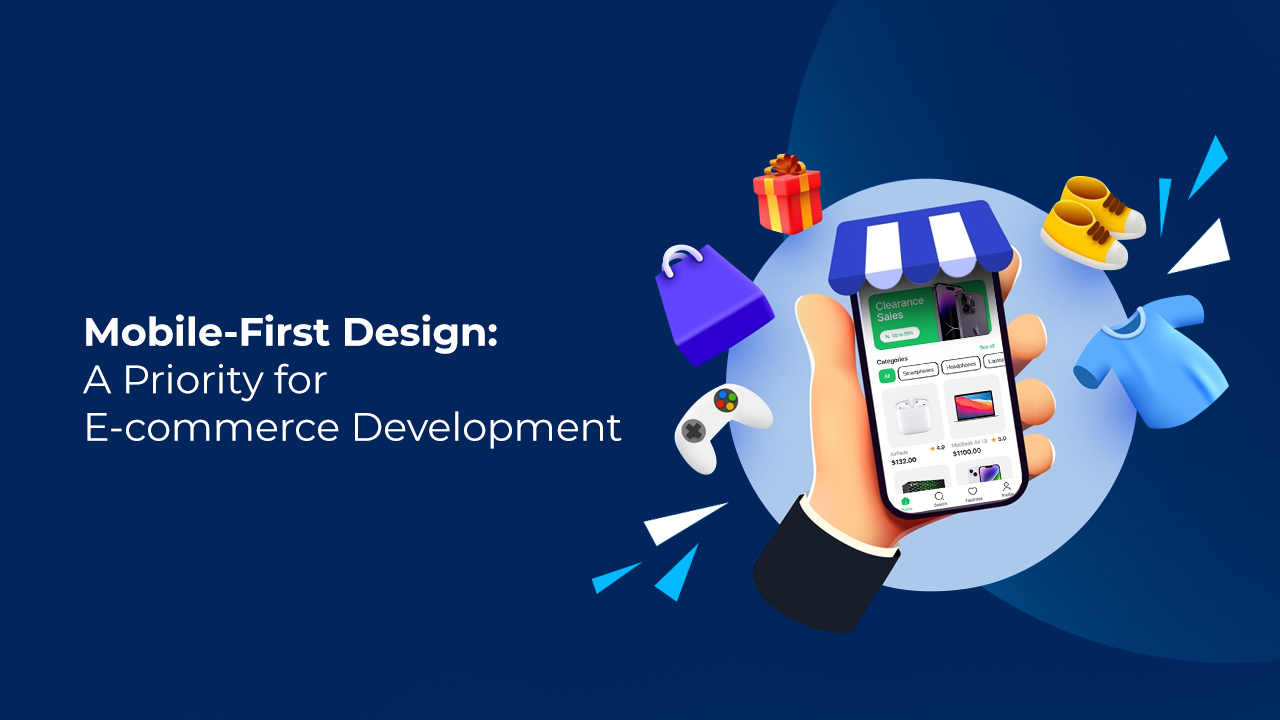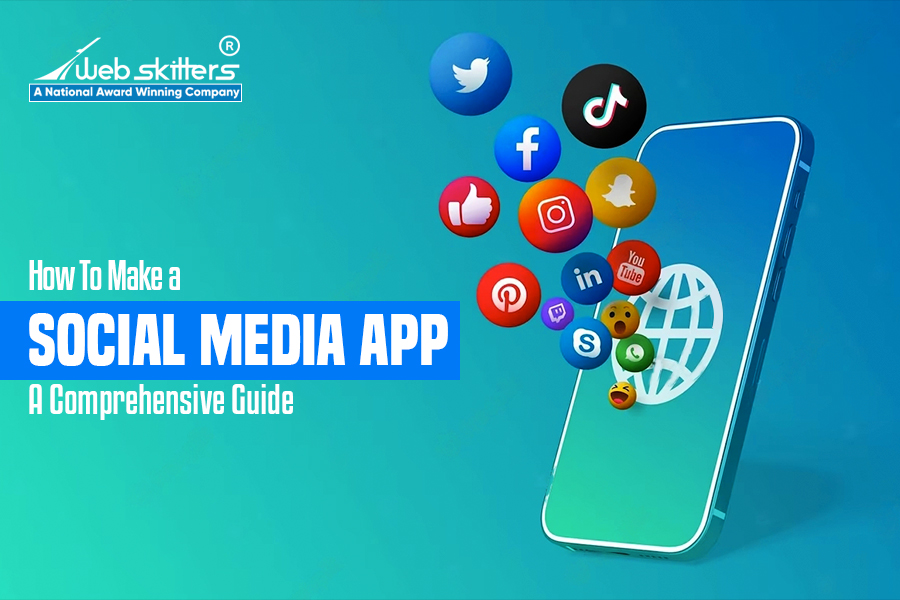“In the ever-evolving world of web design, staying competitive hinges on the timeless Mobile-First design approach.”
These days, almost everything happens on our smartphones. We can connect with friends, attend video calls, and even meet with new people virtually from our phones. Additionally, we handle our banking, stream our favorite shows, and shop with just our fingers. As mobile usage continues to rise, businesses are shifting to the Mobile-First approach.
Mobile-first design is a proven strategy that transforms user experience and sparks creativity. It is a longstanding concept that creates a lasting impact on users. The innovative approach prioritizes creating websites and applications fully optimized for mobile devices.
Adopting this approach is critical for an E-commerce development company to deliver customers a seamless and enjoyable shopping experience. Businesses focusing on mobile e-commerce development improve user engagement and reduce bounce rates and conversions.
With the growing demand for mobile-friendly designs, brands that fail to optimize accordingly fall behind. In this dynamic marketplace, ensuring your cross-platform e-commerce design is mobile-friendly is no longer an addition but a necessity. This comprehensive write-up will discuss everything relevant to mobile design essential for an e-commerce development company’s success.
Understanding Mobile-First Design
Mobile-first design is a modern approach that enables web designers to start product design for mobile devices. It can be done by sketching or prototyping for the smallest screen and then shifting to the larger screen sizes. The priority-based approach usually works first for mobile devices and then for other screen sizes. Prioritizing mobile-first design makes sense because the limited space needs to fit on that tiny screen.
Unlike traditional web design, which often begins with designing for desktops and then scales down to the small screen, the mobile-first approach starts with the smallest screen and builds up. The growing dominance of mobile usage drives the shift. People are more into browsing on their mobiles for shopping and interacting with digital content, and more than ever before.
The core principle of mobile-first design focuses on simplicity, speed, usability, and seamless navigation. It involves designing for the most constrained environment, like mobile screens. The innovative approach forces designers to streamline the content, optimize navigation, and create an intuitive user experience.
The aim is to drive attention with a seamless, easy-to-navigate, and engaging experience. For mobile users, it works like the whole world is assembled on a small screen and controlled with fingertips.
Adopting Mobile-first design plays a vital role for every e-commerce development company. With the rise of mobile commerce, E-commerce mobile optimization boosts growth, improves user engagement, and increases conversion rates.
This innovative approach makes it easier for shoppers to browse and purchase with their phones. Ultimately, it helps to enhance mobile-responsive e-commerce websites, ensuring that the website or applications adapt seamlessly to any device.
In the age of the digital world, mobile-first web development is necessary to stay competitive and deliver exceptional user experience.
The Importance of Mobile E-commerce Development
Mobile e-commerce development mainly refers to buying and selling goods and services through mobile devices. Over the last decade, mobile e-commerce has increased and become part of the modern retail landscape. As more consumers turn to mobile devices for shopping, businesses must embrace a contemporary approach to stay competitive, meet customer expectations, and drive success in the relevant industry.
The dramatic rise of mobile users has surprised the world more than ever. Nowadays, people are more addicted to their phones and use them for browsing, shopping, comparing prices, and more. According to the recent statistics, it was claimed that:
• Around 72% of consumers prefer shopping via their mobile devices at least once a month.
• In 2024, mobile apps had a commerce sales conversion rate of around 3.5% higher than desktop websites.
These numbers are a clear indication that shoppers prefer the ease and convenience that comes with mobile devices.
Moreover, adopting a mobile-first design ensures a smooth shopping experience for consumers. Ultimately, it increases the chances of conversion and repeat business. Here, we will discuss why companies should focus on a mobile-first approach:
• Improved Customer Experience: An E-commerce mobile optimization for conversions ensures a fast load and is easy to navigate. Further, it helps to offer a seamless checkout process for customers’ ease and convenience. Usually, customers are more likely to complete their purchase if the process is smooth and speed is optimal.
• Higher Engagement: Mobile devices provide access to personalized marketing that includes push notifications and location-based promotions. It is the most effective way to drive sales and maximize conversion rates.
• Competitive Edge: Businesses prioritizing mobile development are better positioned to engage and retain customers, keeping ahead of competitors who might still depend on desktop-first designs. The modern strategy is crucial because it caters to the evolving preferences of today’s consumers.
By investing in mobile eCommerce development, businesses can cater to the needs of modern consumers and improve their market position.
Critical Elements of Effective Mobile E-commerce Design
Undoubtedly, the design and layout of an e-commerce site significantly impact sales. Imagine customers cannot find the product they are looking for due to a lack of well-thought-out or organized navigation. You may lose your customer in that instance. People want to experience a seamless and convenient process so they will not dig into your site for hours. Instead, they will prefer to find it somewhere else with easy Google research.
It is not just about getting the “add to cart’ option. Instead, it is about having an e-commerce site with appropriate information and filter options based on research, interest, and validation. E-commerce development companies must help consumers at every stage of their buying journey. For that reason, having a compelling mobile e-commerce design is critical for mobile e-commerce growth and success. Here are the key elements that define successful mobile-friendly e-commerce solutions:
• Responsive Mobile Design
A responsive mobile design ensures that your e-commerce site looks outstanding and functions smoothly on all devices. Whether smartphones or desktops, e-commerce sites should be highly responsive and easy for users to use. For instance, it uses fluid layouts and adaptable images that automatically fit every screen size. The term flexibility is critical as mobile screens are smaller than desktops.
Fluid layout refers to the elements such as buttons, Text, and images resized to fit the screen. It is also considered a seamless layout that offers a seamless browsing experience. The mobile site should load quickly and adjust to different screen resolutions without affecting quality. With responsive design, visitors don’t have to zoom in or scroll horizontally to view the content. It makes shopping more accessible for the shoppers.
• Touch-Friendly E-commerce Interfaces
Today, mobile devices are ubiquitous and depend heavily on touch screens for navigation. This is why designing your e-commerce site with this factor in mind is crucial. Touch-friendly interfaces enhance the user experience, making navigation both simple and intuitive. Buttons must be large enough to tap comfortably, and spacing between clickable items is necessary to prevent accidental clicks.
Menus ought to be easily accessible, and navigation should be clear-cut. Implementing features like sticky navigation bars or “back-to-top” buttons can facilitate users’ movement throughout the site. The overall design should feel fluid and natural. Further, we aim to ensure that mobile e-commerce user engagement is enjoyable and hassle-free. However, attention to these details is essential because they directly impact user satisfaction.
• Optimized Mobile Checkout
Mobile checkout optimization is one of the most critical aspects of mobile e-commerce design. Users often go on the go on mobile devices to minimize friction and make purchasing quick and easy. With this, you can effectively reduce the steps needed to complete simple forms.
Offer guest checkout options to make the process quick. Autofill options in the commerce design will help users quickly enter their shipping details and payment information. Implement easy payment methods like Google Pay to make the transaction more accessible and convenient.
• Fast Loading Speeds
Mobile users have come to expect websites that load swiftly. If your e-commerce platform takes excessive time to load, visitors are likely to depart before finalizing their purchases. Slow loading times can adversely affect your sales. Users are often impatient and may choose to engage with faster, more efficient competitors.
To enhance E-commerce website speed on mobile, consider compressing images, minimizing the usage of heavy scripts, and leveraging browser caching. Utilizing content delivery networks can accelerate load times by distributing content across servers nearer to the user’s location.
Furthermore, ensuring your site is optimized for mobile devices is essential. It includes testing on diverse devices and connection speeds because user experience is paramount.
In summary, a successful mobile e-commerce design focuses on responsiveness, touch-friendly interfaces, and fast loading speed. These elements are crucial for a smooth, enjoyable shopping experience on mobile devices. Prioritize these elements to meet the needs of today’s consumers and enhance your business profitability.
Enhancing Ecommerce Website Responsiveness
In this modern era, e-commerce websites tell how well a site adapts to different sizes, devices, and orientations. A responsive design matters for all whether a customer is shopping on smartphones, tablets, laptops, or desktops. An e-commerce development company ensures that it works to improve user engagement.
For instance, the experts offer a highly responsive and fast load speed website for easy navigation. A responsive website ensures an enhanced user experience with quality design and content automatically adjusted for optimal viewing.
Websites that offer smooth and hassle-free browsing experience are more likely to convert visitors into permanent customers. Better accessibility is the key to driving success effectively. Here, we will explore best practices for ensuring your e-commerce sites are responsive:
• Flexible Layouts: Fluid grids and layouts that adjust to the screen size are essential for better mobile e-commerce development. This means the site’s content, like product images and Text, scales perfectly without breaking the layout.
• Optimize Images: Mobile-friendly e-commerce solutions comprise compressed images to ensure fast loading times. The website’s image content should not sacrifice quality. Make sure your images automatically resize to fit the various screen sizes and keep them sharp and clear.
• Touch-Friendly Navigation: You can start by designing mobile device websites. Afterward, shift to the larger screens, ensuring the mobile experience is optimized. You can also implement touch-friendly navigations such as buttons, links, and menus to avoid small and challenging touch targets.
• Test across Devices: Regularly test the website on multiple devices, including smartphones, tablets, laptops, and desktops. It helps to ensure it displays and functions correctly on all platforms.
Brands like Amazon and Nike follow successful, responsive designs. Amazon’s platform has a highly responsive website that adapts flawlessly to any screen size. Whether you are shopping on your smartphone or desktop, the platform offers convenience and an easy-to-navigate interface. On the other hand, Nike’s e-commerce site delivers smooth functionality on all devices.
The primary objective of the popular e-commerce site is to make it easier for customers. They provide easy navigation to browse the products, checkout, and receive personalized recommendations. All these examples and creativity are possible with the practical mobile-first approach from the finest E-commerce development company.
Ultimately, an e-commerce site can improve brand identity and drive dramatic success by following best practices and focusing on responsive design.
Strategies for Optimizing Mobile Performance
When it comes to e-commerce, a fast and responsive mobile site plays a significant role. Attracting customers and engaging them with stunning design and responsiveness is essential. To make sure your site performs well on mobile devices, consider the following critical strategies for optimizations:
• Image Optimization
Images are undoubtedly the heart of the website and play a big role in how your website actually looks. However, due to slower connections, images can slow down loading times, especially on mobile screens. For better outcomes, it is important to optimize images effectively to boost overall performance without sacrificing quality.
Prefer tools like TinyPNG or ImageOptim to reduce the size of images without compromising quality. Smaller image files load faster, use less data, and enhance user experience. Use smaller dimensions of the image to fit into the mobile screens. Implement lazy loading so images only load when the user scrolls down the page. If you prefer loading all at once, it takes time. Overall, these image optimization steps improve initial page load speed.
• Minifying Code
For effective mobile performance for e-commerce sites, magnification of code helps reduce files and make the site load faster. A website’s HTML, CSS, and JavaScript often contain unnecessary characters, slowing down page load times. To overcome that, make sure to remove excess whitespace and comments from the HTML files and make them lighter.
Furthermore, minimize CSS and JavaScript files by eliminating unused code and shortening variable names. Simplifying your code improves your site’s performance on mobile devices.
• Implementing Caching
Caching is a technique for storing parts of your website, such as images, styles, or whole pages. This method allows users to not reload the same page every time they visit. It is an effective approach that significantly improves load times for returning visitors.
Implement browse caching for effective mobile performance. When users visit your site, their browser can store static files such as CSS and images. They don’t need to reload the same filé the next time they visit. Further, a static page version can be stored on a server to serve quick response. Ultimately, the caching technique reduces the loading times and gives users a faster and more efficient experience.
• User Engagement Tactics
Keeping users engaged on your site is the key to increasing mobile conversion. Numerous effective tactics can encourage users to return and interact with the website.
Implement a push notification system to send reminders and important messages to users about sales, promotions, or new products. Push notifications allow users to spend time and return to your site. Utilize personalized content based on the user’s history or preferences. This will help create a more relevant shopping experience and encourage customers to make purchases.
These simple yet powerful tactics ensure that your customers have a fast, enjoyable shopping experience, regardless of their device.
Future Trends in Mobile-First Ecommerce Design
As mobile shopping grows, e-commerce development companies adopt new technologies and trends to enhance user experience. Here are the critical mobile-first e-commerce trends that assure to contribute to shaping the future of mobile-first E-commerce design:
• Increased Use of AI and Chatbots for Customer Service
Artificial Intelligence (AI) and chatbots are becoming popular tools for e-commerce sites. Regarding mobile devices, the use of AI and chatbots enhances user experience. AI-powered chatbots offer instant customer support, answer questions, and help users to find products quickly.
Chatbots can easily suggest products based on the user’s history, preferences, or past purchases. As mobile users expect fast responses, the integration of AI works magically and offers 24*7 customer service.
• The Rise of Voice Commerce
Voice commerce or shopping via voice commands is continuously gaining popularity. Voice assistants like Siri, Alexa, and Google Assistant have the potential to drive success most effectively. People are increasingly using smartphones or smart speakers to find suitable products and services.
To prepare for this significant shift, e-commerce businesses must optimize their sites for voice search. This involves focusing on natural language processing and enhancing product descriptions to be more conversational. Voice commerce, however, will render shopping even more hands-free and efficient because it streamlines the purchasing process.
• The Growing Importance of AR/VR for Enhancing the Shopping Experience
Augmented Reality (AR) and Virtual Reality (VR) fundamentally reshape the online shopping experience, particularly on mobile devices. AR enables customers to envision products within their environment. For instance, it includes observing how furniture might appear in their living room before purchasing.
On the other hand, VR can facilitate virtual “try-ons” for clothing or accessories. It provides users with a more accurate sense of fit and style. However, as mobile devices continue to advance in power, AR/VR technology will increasingly influence how customers engage with products online.
Moreover, mobile-first e-commerce design is rapidly evolving; AI, voice commerce, and AR/VR are significantly shaping the future. Businesses that successfully adapt to these trends will offer customers more personalized and convenient shopping experiences with immersive mobile shopping experience optimization. This adaptation is crucial because it helps them remain competitive in a more mobile-driven marketplace. Although challenges persist, the potential for innovation in this space is immense.
Partner With Webskitters and Stay Ahead of the Curve of Mobile-First Design!
In conclusion, adopting a mobile-first design approach is essential. E-commerce development companies are more focused on a comprehensive mobile user interface for the users. The traffic coming from mobile browsing is surpassing desktop users. This is why prioritizing mobile design ensures your website is more accessible, user-friendly, and ready to capture a growing audience.
The mobile-first approach is a long-term investment that ensures your brand remains competitive and future-proof in an ever-evolving digital world. Rely on the best e-commerce development company to take advantage of innovative trends and lead the business successfully.
Get your desired mobile-first design with Webskitters Technology Solutions Pvt. Ltd. Our expertise ensures the creation of responsive, mobile-optimized platforms for your e-commerce business. Let us help you build a seamless shopping experience to boost customer satisfaction.
Mobile-first design isn’t just a trend; it’s the future, it’s the success!


 December 27, 2024
December 27, 2024 








